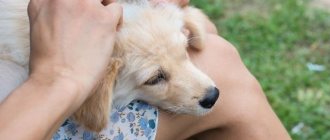The appearance of purulent discharge from the eyes is the main symptom of the inflammatory process. If you don’t find out why your dog’s eyes are festering and don’t start treatment as soon as possible, sepsis will develop. This complication spreads to the bloodstream, so all internal organs and systems are affected.
Causes of pathology
Conjunctivitis acts not only as an independent disease, but also as a symptom of another disease. When bacteria enters an animal's eye, disease immediately spreads. Most often this can happen when the animal's immunity weakens. In addition, veterinarians note a number of reasons that can give impetus to the development of eye disease in dogs:
- injury to the organ of vision;
- contact with chemicals in the eye;
- inflammatory processes concentrated on the eyelids or cornea of the eye;
- getting small particles into the eye, such as dust, hair, etc.;
- infectious diseases of an endogenous nature;
- hypothermia of the animal;
- burns of the organ of vision;
- lack of vitamin A in the animal’s body;
- allergic reactions;
- viral and microbial infections in the body;
- eye diseases that affect the tear ducts;
- poor metabolism;
- ingrown eyelashes.
In addition to these common causes, veterinarians note that Doberman Pinschers and Great Danes are most prone to this disease. It is important for the owners of these animals to be attentive to the condition of their eyes.
Pugs, bulldogs, Yorkshire terriers and Pekingese may also be considered at increased risk. If you are the owner of a dog of this breed, remember that their eyes are at high risk of infection with various pathologies.
Chlamydia as a cause
Chlamydial conjunctivitis is a fairly serious disease, and this no longer concerns the dog, but the people who live next to it. Chlamydia is extremely dangerous for humans. The problem is that it is extremely difficult to distinguish it from the usual bacterial type of pathology:
- a lot of thick pus is released from the affected eye;
- Damage to the reproductive and respiratory systems may be observed.
If a dog has lost its puppies and simultaneously develops conjunctivitis, immediately isolate the animal from people.
General signs
The disease has common symptoms for all species, with the help of which the dog owner can easily understand that his dog is suffering from conjunctivitis:
- discharge from the eyes;
- the palpebral fissure narrows;
- the dog begins to blink frequently;
- eyes close;
- the animal is bothered by itching;
- eyes turn red;
- the conjunctiva swells;
- bubbles form (in the chronic form).
When diagnosing conjunctivitis, you need to monitor the hygienic treatment of the animal’s eyes, after which the veterinarian will prescribe medications.
Conjunctivitis begins to develop in dogs when pathogens (bacteria, viruses) enter the mucous membrane of the eye. If the animal’s immunity is weakened, the body cannot cope with this problem on its own. This leads to the development of an inflammatory process.
In addition, the following factors can provoke this disease:
- Eye injuries.
- Hypothermia.
- Burns.
- Getting small particles of dust, fur or lint into your eyes.
- Allergic reaction to chemicals.
- The presence of concomitant infectious and inflammatory eye diseases.
- Vitamin A deficiency.
- Metabolic disease.
- Trichiasis is a disease in which the eyelashes on an animal's eyelid grow inward.
Dog breeds at particular risk include Dobermans, Pekingese, bulldogs, Yorkshire terriers, pugs, and Chihuahuas. This is due to the special structure of the eye in these animals. They have a slightly convex shape of the eyeball, which contributes to more frequent eye injury and foreign bodies getting into the conjunctiva.
A Yorkshire Terrier's eyes can become watery or festering for many reasons.
The eyes are often subject to inflammation due to a number of reasons:
- Hair is not pulled back into a ponytail. If the bangs constantly get into the dog's eyes, it will cause irritation to the mucous membranes of the eyes.
- There are bacteria on the bangs. In this case, the hair is a carrier of harmful organisms, which, when they get into the eyes, cause suppuration.
- Hair tied tightly. Many owners try to tighten the elastic band on their pet's forehead so that the upper eyelids lift. As a result, the conjunctiva becomes exposed, tears begin to be released in huge quantities, and pathogenic microflora joins.
- There is an infectious disease.
- Obstruction of the tear ducts. Suppuration of the eyes can also be caused by the fact that the dog’s tears stop going into the nasal cavity.
The disease develops after various microbes from the external environment enter the mucous membrane of the eyelid. Bacteria and viruses accumulate in the conjunctival sac and begin to multiply under favorable conditions.
With conjunctivitis, the lining of the dog's inner eyelid becomes inflamed.
The entry of pathogenic microflora into the eye is not dangerous for a healthy animal with a strong immune system. The body destroys harmful viruses on its own, and the disease has no chance.
Inflammation cannot be avoided if the animal’s body is weakened. In this case, microbes linger inside the eye and begin to actively multiply.
The cause of the disease can also be diseases of the eyes (see stye on the eye in dogs) and other organs.
The disease has only one cause - the proliferation of pathogenic microbes and fungi on the pet’s conjunctiva. Here you need to understand that the body constantly encounters pathogens, but usually it can destroy them on its own (that is, it has resistance). However, in some cases, resistance to infection decreases.
Experts list a number of predisposing factors as follows:
- damage to the conjunctiva due to eye injury;
- contact of a chemical with the eye;
- infection in the eye with foreign bodies, such as sand, dust;
- infectious diseases of an endogenous nature;
- lack of vitamin A;
- burns or hypothermia;
- metabolic disease;
- ingrown eyelashes;
- any other eye diseases.
Dobermans, pugs, Pekingese, Yorkies, bulldogs and Great Danes suffer from conjunctivitis more often than other dogs. In this regard, owners of these breeds need to carefully monitor the health of their pet's eyes.
Why do Yorkshire Terriers' eyes water?
There are several reasons for lacrimation:
- irritation;
- inflammation;
- allergy;
- Epiphora disease;
- development of pathology against the background of other diseases.
Regular hair on a pet's face can irritate the cornea if the hairs come from the area around the eyes. The owners of their pets often use tight elastic bands and very tightly braid the tails of their Yorkies. This can cause irritation of the mucous membrane, as the conjunctiva moves away and the process of natural hydration is disrupted. This is the first reason why Yorkies have runny eyes.
Inflammation occurs due to pathogenic bacteria and viruses entering the mucous membrane.
The most common source is dirty fur that comes into contact with your pet's eyes. Attention! The dog is usually bathed once a week, but he walks outside several times a day.
Therefore, wool is the first source of inflammation. A dog can also get inflammation in a draft in an apartment or in a car with open windows. Since Yorkies do not have an undercoat, they are very sensitive to cold. Why do Yorkies have watery eyes after bathing and grooming?
An allergic reaction, like in humans, can occur to:
- Food;
- Construction Materials;
- plants, poplar fluff, flower pollen.
By observing what exactly has changed in your pet's environment, you can determine the source of the allergen. The renovation that was started in the room where the dog lives. In the spring season, pollen, dust, and poplar fluff can fly. And sometimes an allergenic plant settles on the window in the form of an indoor flower.
Food allergies can occur due to a sudden change in food. Poor quality chicken meat often causes peeling skin on the body and can also cause a tearful reaction. Of the prohibited foods that are generally contraindicated for dogs, sweets and chocolate are one of the first causes of problems with lacrimation.
It is important to know! The digestive system of Yorkshire terriers is prone to allergies to food, low-quality products, and sugar-containing products.
With Epiphora disease, there is a continuous release of fluid. Mucus occurs due to disruption of the normal functioning of the lacrimal systems. A specialist can determine the exact diagnosis and cause.
Discharge can be a symptom of other diseases. If, against the background of lacrimation, the dog has apathy, elevated body temperature and refusal to eat, this could be distemper. Inflammation of the ears can also cause drainage from the eyes.
The photo shows that the disease is becoming more severe. The discharge has lasted for more than one day, the mucus is not clear, the eye is swollen.
What is meningoencephalitis?
Meningoencephalitis is an inflammatory process in the brain of dogs. This disease often passes so quickly that the animal simply dies before our eyes. With meningoencephalitis, the brain itself and the cerebral cortex are affected.
Bacterial meningoencephalitis can be caused by plague and viral infections, and non-bacterial meningoencephalitis can be caused by helminthic infestation and traumatic brain injury.
The prognosis of this disease is disappointing - the mortality rate is very high due to lack of response to drugs.
Treatment depends on what type of meningoencephalitis. Usually prescribed injections of cytarabine, antibiotics ampicillin, enrofloxacin. Therapy is continued for 2 weeks. In addition, vitamins and anticonvulsants are prescribed.
General signs of conjunctivitis
- Redness of the conjunctiva.
- The appearance of edema.
- Severe lacrimation.
- Itching.
- Photophobia.
- Discharge from the eyes (mucous, watery, purulent).
- Frequent blinking or complete closure of the eye.
- Poor appetite, deterioration in general health.
- Increased body temperature.
- discharge from the eyes (watery, mucous, purulent),
- narrow palpebral fissure,
- blinking,
- closing an eye,
- itching,
- redness,
- swelling of the conjunctiva,
- formation of bubbles (chronic course).
Treatment of conjunctivitis is initially aimed at hygienic treatment of the eye and the use of various eye medications (depending on the nature of the inflammation). These may be drops or ointments containing glucocorticoids or antibiotics. The active ingredients in them are aimed at reducing swelling, itching and excessive lacrimation; have anti-inflammatory and antibacterial effects.
How to care for your dog's eyes
It is a mistake to think that a dog can maintain visual hygiene on its own. Veterinarians recommend regularly caring for your pet's eyes. All events can be divided into three categories:
- regular hygiene,
- preventative treatments,
- treatment.
Eye hygiene
This is a set of necessary measures that allows you to maintain the health of your dog’s visual organs. Daily hygiene is of particular importance for animals with bulging eyes or “bangs” - long hair on the face. Dogs with such features are predisposed to injuries, inflammatory processes and other diseases of the visual organs.
Veterinarians recommend using eye drops for daily hygiene or a sterile saline solution for dogs. In extreme cases, boiled water will do. The drug must be applied to a sterile gauze swab or cotton pad with a smooth surface and carefully remove all dirt and dried exudate from the outer corner of the eye to the inner one. Treatment should be carried out regularly, depending on the intensity of lacrimation and the rate of formation of dark crusts in the corners of the eye. Long “bangs” are removed from the eyes and secured with hairpins.
Disease Prevention
Preventive measures aimed at preventing the development of diseases of the organs of vision are of great importance for four-legged pets. Eye treatment should be carried out on dogs that exhibit the following characteristic signs:
- formation of mucus in the inner corner of the eye. Mucus may appear after sleep or accumulate throughout the day;
- the appearance of dark tracks running from the inner corner of the eye down the muzzle. These are the so-called tear tracks, which indicate increased secretion of tear secretion.
Consultation with a veterinarian allows you to identify the onset of the inflammatory process and begin a course of treatment in a timely manner. The specialist will recommend medications that will help eliminate inflammation, destroy pathogenic microflora and alleviate the animal’s condition.
Treatment
If the dog has signs of the development of a pathological process (suppuration, mucous or bloody discharge), and squinting, whitish spots or stripes on the cornea appear, then you should immediately visit a specialist. The veterinarian will conduct an examination and identify the cause of the disease. Timely treatment using medications with anti-inflammatory, bactericidal, anti-edematous effects will most likely preserve your pet’s vision.
Necrotizing encephalitis
Necrotizing encephalitis has been poorly studied and is practically untreatable.
Most common symptoms:
- decreased appetite;
- weight loss;
- limping;
- lack of coordination;
- sudden change in behavior;
- pain;
- convulsions.
Timely detection of symptoms of the disease and contacting a clinic can, despite the poor prognosis for this disease, lead to positive results.
As a result of the examination, the veterinarian will prescribe surgical or other treatment.
Treatment
After contacting the clinic, the doctor will examine the pet and determine why the dog’s eyes are festering, and will also recommend how and with what to treat it.
Contrary to popular belief, eye drops rarely help completely get rid of pus when inflammation of the conjunctiva develops in a dog. The drops wash the eyes and only wash away the secretions, and for treatment it is necessary to use ointments. To relieve inflammation during the development of conjunctivitis and blepharitis, antibiotic ointments are needed: Floxal ointment, Tetracycline eye ointment. They need to be used 2-3 times a day for at least two weeks. Often antibiotics are prescribed orally in a minimal dose, for example, Sinulox.
However, when a corneal ulcer develops, it is drops that are needed; they penetrate well through the mucous membrane and help healing. For treatment you will also need moisturizers - Systane Ultra, Oftalik, Korgergel, and antibiotics - Tobrex drops, Floxal, Ciprovet. They must be dripped at least four times a day.
Do not forget about hygiene and rinse your eyes before each instillation of drugs.
Pannus in shepherds, on the contrary, requires the use of drugs that suppress the immune system. In veterinary practice, Optimmune and local hormonal drugs are used. When outdoors, your dog needs to wear sunglasses to protect against ultraviolet radiation. Therapy is carried out for life.
Pathologies such as prolapse of the lacrimal gland, cartilage congestion, entropion of the eyelids, eyelashes, and eye tumors can only be treated surgically.
We recommend that you consult your veterinarian for the use of all of these medications!
Prevention
To avoid inflammation, perform eye hygiene regularly - after walking, playing or contact with other dogs.
Follow the rules of animal hygiene - regular treatment for parasites, vaccination, proper feeding and grooming.
Before adopting a puppy, find out about its parents, whether they suffered from breed-related diseases or whether they underwent surgery.
Get checked regularly by your veterinarian. The doctor will notice pathologies such as entropion of the eyelids, eyelashes and pathologies of the third eyelid at an appointment in the early stages, which will allow the situation to be quickly corrected.
Symptoms of conjunctivitis in dogs
You can also suspect the disease by paying attention to the behavior of your pet. Since conjunctivitis is accompanied by a feeling of discomfort and severe pain localized in the visual area, the dog becomes nervous, irritable, passive, often closes its eyes and rubs its eyes with its paws.
Often with conjunctivitis, the animal experiences sleep disturbances and a permanent lack of appetite.
Since conjunctivitis in dogs can occur in different forms, the symptoms of the disease are slightly different. So, with catarrhal conjunctivitis, the membrane of the pet’s eye is red, swollen, and sometimes protrudes from under the eyelid.
Also with this form, serous discharge from the eyes is observed. profuse lacrimation.
The catarrhal form of conjunctivitis begins acutely; if not treated in a timely manner, it becomes a chronic disease and is very difficult to treat.
The purulent form of conjunctivitis is characterized by liquid purulent discharge from the eyes, which over time acquires a yellowish and thick consistency. Swelling and redness of the eyes, a depressed state of the animal, and refusal to eat are also observed.
In the follicular form of conjunctivitis, inflammation of the conjunctiva is very noticeable, and dark red follicles are visible on the inner surface of the third eyelid. This type of conjunctivitis, as a rule, occurs in a chronic form over several years with periods of exacerbation and attenuation.
The most common causes of conjunctivitis in dogs are mechanical or chemical damage to the membrane. When exposed to grass, sand, insects, wool and microorganisms, the connective tissue of the eye shell becomes inflamed, which leads to conjunctivitis.
Also, the dog's eyes may be irritated by smoke or caustic gases; viral or fungal infections; allergies in animals.
It is important to note that conjunctivitis can become a concomitant disease with diseases such as plague, hepatitis and others. Pekingese and French bulldogs with bulging eyes are also at risk for conjunctivitis.
Most often, with the purulent form of conjunctivitis, inflammation develops in both eyes, but there are cases with damage to only one side. Determining the type of inflammation is not difficult, but to determine the type of pathogen it is necessary to take exudate from the conjunctiva.
Acute purulent conjunctivitis
In the acute form, the symptoms are as follows:
- swelling of the eyelids;
- fear of light;
- blepharospasm;
- temperature rises;
- the conjunctiva turns red;
- severe pain in the conjunctiva and eyelids.
But the most characteristic symptom is purulent discharge from the eyes. They are thick white or with a yellow tint. In the morning, they glue the animal's eyelids together, which makes it difficult for him to open his eyes. The pus may have a slight admixture of blood; it accumulates on the inner corner of the eye, causing wet eczema to form underneath.
Chronic purulent conjunctivitis
The disease becomes less noticeable. Photophobia and pain may disappear, but the conjunctiva often becomes bluish in color (due to stagnation of blood). In this case, part of the conjunctiva protrudes and becomes ulcerated and necrotic. The pus becomes thick, gray-yellow in color with an unpleasant odor, and its amount decreases.
Associated symptoms
In addition to discharge of various types, the disease is accompanied by other symptoms. In addition to obvious visual changes, with prolapse of the lacrimal gland, cartilage fracture or eye neoplasm, general accompanying symptoms develop.
Swelling of the eyelids
occurs due to itching, irritation of the skin by accumulated secretions.
Redness of the conjunctiva or eyelid skin
. Any inflammation is a flow of blood to the site of penetration of bacteria, as a result, the mucous membranes and skin change color and turn red.
Blepharospasm
is a condition in which the dog blinks intensely or barely opens its eyes. This is a protective reaction of the eye to pain, burning and itching.
Epiphora
– increased production of tears, the fur around the eyes is wet and changes color.
Photophobia
– the dog hides in dark places, covers its eyes with its paw, and refuses to go outside.
Hair loss on the eyelids.
When there is a heavy accumulation of secretions, the fur constantly becomes wet and the skin becomes inflamed, resulting in bald patches.
Narrowing of the palpebral fissure
. Occurs due to swelling and redness of the mucous membrane of the eyes.
The general condition of the dog changes, it sleeps a lot, appetite and activity
b
can also be significantly reduced
.
the temperature
may rise .
If left untreated for a long period, the dog may go blind
. Without timely assistance, shepherd pannus, corneal ulcers, dystrichia and ectopic eyelashes, entropion of the eyelids, prolapse of the lacrimal gland and neoplasms inevitably lead to blindness.
Drug treatment
How to treat conjunctivitis in dogs? Treatment of the disease must follow an individual regimen and is prescribed by a veterinarian. Therapy depends on the type of pathology and its severity. Before visiting a doctor, the dog's owner can alleviate its condition himself.
When the dog is undergoing treatment, avoid spending a long time on the street; this will be an additional insurance against microparticles of dirt and street dust getting into the eyes. You also cannot get hypothermia, it will only worsen the dog’s condition.
How to treat conjunctivitis in dogs? As medications, veterinarians use antibacterial drugs, antibiotics, ointments, bactericidal drops, and tablets that are taken orally to relieve inflammation in the body. It wouldn’t hurt for your dog to take a vitamin course that will boost the immune system and the protective properties of the whole body.
When conjunctivitis becomes allergic, antiallergic drugs and drops with an antiallergic effect must be prescribed in treatment. Most often, to begin with, the dog’s eyes are treated with a cotton pad, previously soaked in a decoction of suitable herbs, then dripped, and then an ointment prescribed by the veterinarian is applied.
This scheme is repeated approximately 4 times a day for a couple of weeks. Everything will depend on how well the dog feels and on the severity of the pathology.
Keratoconjunctivitis sicca in dogs is considered incurable. However, you should not let the course of the disease fade away. You can greatly reduce unpleasant symptoms. Broad-spectrum antibiotics, allergy medications, and tear replacement medications can be used. In many cases, surgery is used.
Treatment of catarrhal conjunctivitis in a dog should be carried out under the supervision of a veterinarian. However, according to reviews from owners, when the first signs appear (tears, redness, blinking), the disease can be dealt with without contacting a specialist.
Folk remedies
Until you can show your animal to a veterinarian, you can carry out the following procedures yourself:
- Rinse the dog's eyes with a cotton pad soaked in strong tea, chamomile decoction, furatsilin or a slightly pink solution of potassium permanganate. This must be done several times during the day. This procedure will help remove accumulated exudate in the corners of the eyes.
- Remove purulent crusts using Vaseline ointment.
- Make a compress from eyebright herb. Take 10 g of this herb, pour a glass of boiling water and leave for several hours. This decoction has good antibactericidal and anti-inflammatory effects.
In order to cure this pathology, it is necessary to urgently contact a veterinarian. He will conduct a thorough eye examination, take a culture of microflora from the diseased eye and prescribe the necessary treatment. Normally, the conjunctiva of the eyeball is pale pink in color, with a smooth surface and moderate moisture.
Also
It is important to promptly and accurately determine the reasons that could trigger the development of the disease. Conjunctivitis does not always manifest itself as an independent disease; sometimes such symptoms indicate metabolic disorders or the onset of infectious diseases.
Treatment of conjunctivitis in dogs is based on the use of ointments and drops containing antibiotics or glucocorticoid substances. They have anti-inflammatory and bactericidal effects.
In case of an allergic form, the doctor prescribes antihistamines.
Before taking action, you need to find out what is causing the inflammatory process, and only then decide how to treat your Yorkie at home.
If the cause is hair getting into the eyes, then you need to treat the dog’s bangs. Shampoo for Yorkshire Terriers is suitable for these purposes. Wash your bangs, rinse thoroughly, dry and tie them into a ponytail with an elastic band. At the inner corner of the eyes the hair is usually not long enough to be pulled back into a ponytail. Therefore, it is cut to the optimal length.
If pus has dried on the eyelids, you need to soak it using cotton wool moistened with a 0.05% solution of chlorhexedine or ordinary warm water (boiled). Soaked crusts can be easily removed with a dry cotton swab or napkin.
When the pus is removed, drops such as Bars or Iris can be placed into the eyes. 2-3 drops per eye, instilled at least 3 times a day, are enough.
Eye problems should disappear after 3-4 days. If this does not happen, you will have to show the animal to the veterinarian.
First of all, you need to remove the dog’s bangs into a ponytail and cut the hair around the eyes short.
Don't forget about traditional medicine. You can prepare silver water to treat your Yorkie's bangs and eyes. To do this, place a silver object in a glass of clean water and keep it there for 2 days.
Every day, our beloved pets, including dogs, walk a lot of time in the fresh air, communicate with other animals and therefore have many risks of contracting various infections. One such disease is conjunctivitis.
It affects the mucous membrane of the eye, which lines the inner surface of the eyelid and the eyeball. This disease is quite common in pets.
To treat conjunctivitis, an accurate diagnosis is necessary. The cause of inflammation is determined by a specialist based on the results of a visual examination and a survey of the dog’s owner. Important information is provided by cultures of swabs from the diseased eye. This makes it possible to identify the specific causative agent of conjunctivitis in order to prescribe specific treatment.
The course of treatment for the disease consists of ointments (Tetracycline, Chlortetracycline, Etazolic) and drops (CiproVET, Sulfacyl sodium, Levometicin, Sofradex). Apply the product for 5-6 days four times a day. Drops and ointments are combined for severe inflammation, the interval between use is 10-15 minutes. Severe swelling is relieved with Dexazone.
IMPORTANT. Before instilling or applying the ointment, the eyes must be washed with disinfectant solutions (furatsilin, boric acid), and dry films are carefully removed.
Conjunctivitis in dogs is treated with drops and ointments that are placed behind the lower eyelid.
The newest method of treating eye diseases in dogs is special medicinal films. They attach to the eyeball, completely dissolve on it and produce a therapeutic effect. This type of treatment for conjunctivitis is very convenient, since the use of drops and ointments is not always convenient, due to the danger of causing additional eye injuries during the procedure.
If conjunctivitis is a consequence of another disease, first of all, you need to treat the root cause. With a viral etiology of the disease, intramuscular administration of antibiotics may be necessary.
Along with drops, the doctor prescribes immunostimulation of the body. A good effect is achieved by taking vitamins B, A, E and immunomodulators (see the drug Fosprenil).
As soon as you notice that your dog's tearfulness has increased, you should wash the animal's eyes as often as possible with a cotton pad soaked in boiled water. In this case, the dog should be given rest, not walked in windy weather and avoid physical activity. Your pet's contact with other dogs should also be limited, as this disease can be contagious.
If symptoms worsen, which are characterized by redness of the eyes, you should immediately consult a doctor who will prescribe anti-inflammatory and antibiotic ointments or eye drops. The most effective are: Sulfacyl sodium (10-20-30%), Kanamycin (0.1%), Levomycetin ointment and Sofradex drops.
The following ointments have also proven themselves very well in the treatment of conjunctivitis: Sulfacyl, Tetracycline, Etazolic. In case of severe swelling, a mixture of hydrocortisone and novocaine solution or the drug Dexazone is injected under the conjunctiva.
Also in the treatment of conjunctivitis, special eye films are used that contain kanamycin, nemycin and sulfapyridazine. They are inserted into the conjunctival sac using special anatomical tweezers.
The principle of operation of these eye films is that, when wetted by tears, they swell and stick to the conjunctiva, after which they envelop it and dissolve. This provides a high therapeutic effect.
As for the use of antibiotic ointments and eye drops, they should be dripped into the animal at least 4 times a day for at least 5 days. In this case, the dog’s eyes are regularly washed with boiled water, a solution of novocaine and a solution of boric acid.
Inflammation of the conjunctiva, the lining of the inner eyelid, develops under the influence of viruses, bacteria or fungi that enter the eye. The purulent discharge that accompanies the disease causes a lot of inconvenience and can cause complications, so conjunctivitis in dogs should be treated immediately after the first symptoms appear.
With timely treatment, any complications can be avoided. But if the animal is not treated, then the inflammation spreads to the cornea and tear ducts.
As a result, the dog goes blind, the disease becomes more complicated with the formation of purulent follicles and sepsis. It is possible to save a pet’s life in such severe cases, but it will not be possible to restore vision.
Treatment consists of symptomatic and specific therapy with the mandatory use of antibiotics.
Specific therapy
First aid and treatment
It is better to entrust the treatment of suppuration to a doctor. If there is no opportunity to visit it in the near future, then first aid will have to be provided on your own.
Washing at home
Do not use antibiotics or other drugs until diagnosed at a veterinary clinic. Warming up is no less dangerous - they increase inflammation and worsen the animal’s condition.
Before treating pus, place your pet in a room protected from bright light. This will reduce any existing irritation.
To provide first aid you will need:
- Carefully examine the dog's eyes, remembering to disinfect your hands. You can remove a stuck foreign object yourself, but only if this does not aggravate the injury.
- Dissolve furatsilin in warm water. To prepare the solution you will need 1 tablet per 1 glass of water. Instead of furatsilin, you can use chamomile, calendula or St. John's wort. In this case, you will need 1 tbsp. l. dry ingredient per 1 cup of boiling water. After an hour, be sure to strain the broth through cheesecloth to remove solid particles and cool before using.
- Soak a cotton pad in the resulting solution and wipe both eyes. Move from the outer corner to the inner corner and do not use cotton wool.
- Repeat the previous step 4 times, remembering to constantly change the cotton pads. One procedure should take 8 pieces - 4 for each eye.
- Gently blot the treated area with a lint-free cloth or paper towels.
- Lubricate the lower eyelid with 1% tetracycline ointment, close it and massage. Instead of ointment, you can use 2 drops of albucid or chloramphenicol.
After treatment, reassure your pet and monitor its condition before visiting the veterinary clinic. During this time, stop any attempts to scratch. A special collar will help to cope with this problem.
When to go to the veterinary clinic
You should seek help from a doctor in case of crust formation, fever, helminth infection, severe mechanical damage, or discharge from both eyes at once. Head injuries can cause a concussion, so the injured pet requires emergency care.
After examining and conducting the necessary tests, the veterinarian will understand what to do if the dog’s eyes are still festering. Depending on the diagnosis, drug or surgical therapy is used. Surgery is necessary to realign the eyelid or remove a blocked tear duct.
Ointments, drops and tablets prescribed by a veterinarian
The dosage of eye drops (Bars, Anandin, Tsiprovet) and other drugs is determined by the veterinarian, since self-medication can result in a burn of the mucous membranes. Based on the root cause of a dog’s eye festering, they determine how to treat inflammation:
- healing ointments that eliminate damage after injuries;
- antihistamines, suppressing the production of histamine in the presence of allergies
- anthelmintics that destroy worms;
- antibiotics and antivirals that fight infection;
- vitamins and immunomodulators that increase immune strength in chronic diseases.
Remember that eye drops must be placed in both eyes, even if only one is affected. All medications are selected individually, so do not buy medications until you receive recommendations.
Recommended vaccinations
Professional dog breeders advise using drugs from foreign manufacturers to vaccinate Yorkies:
- NobivakLepto;
- NobivakDHPPI;
- Hexadog;
- Eurican.
It is necessary to re-vaccinate as it expires after a year. These drugs have gained popularity due to the fact that pets tolerate them well.
How to give a dog a pill?
- In many cases, the tablet can be wrapped in a piece of meat or other treat that the dog will eat with pleasure.
- If the pet eats the treat, but the tablet remains unswallowed, then more radical measures can be taken. To do this, before giving the tablet, prepare a small amount of water, for example, in a syringe without a needle.
- The dog's upper jaw is grabbed with one hand from above so that the index finger and thumb hold the mouth behind the fangs.
- With the second hand, place the tablet on the root of the tongue (tweezers can be used) and immediately close the mouth, holding it closed.
- Raising the lip, a small amount of water is injected between the teeth from a syringe, thereby forcing the dog to make swallowing movements.
- After 15-20 seconds, the dog is released and observed whether the pet managed to swallow the tablet.
Some drugs can be crushed into powder and given with a small amount of water.
Good afternoon. We live in Belgorod.
Our dog is 2 years old.
and for the last 1.5 we have been suffering with the eye.
In general, this is how things stood. At first, the veterinarian told us that she had conjunctivitis and prescribed medicine.
it did not pass. Then they said again that it was conjunctivitis.
treated.
it did not pass. Then they said that the dog’s eye had grown, but the eyelid had not stretched.
Therefore, the eye rubs and festers. Then they said again that it was conjunctivitis.
they were dripping again. Then they said that it was a torsion of the eyelid and that I needed to have surgery.
They had an operation. The eye began to fester again in less than a month.
We were told that we had demodicosis and were prescribed to smear our eyes with Demolan. In general, nothing helped.
The eye festered and festered endlessly. 2 months ago, the same wonderful doctor told us that we needed to cut the eyelid again, they didn’t cut out much then (although the dog’s lower eyelid was protruding and did not go back into place even after such an operation).
Literally a day later, I noticed that a cloudy film seemed to be swollen on my eye.
several mm area of the spot. When the doctor looked at this spot, she touched it with an instrument and it turned out that there seemed to be air there.
We went to another veterinarian. They immediately took a swab from our eyes.
It turned out that a MUTANT lives in the eye. Some kind of coc, but not staphylococcus, not streptococcus, it’s not clear what.
A total of 6 antibiotics were injected: 1) Cefoxitin (boncephin) 2) Gentamicin 3) Enrofloxacin (we gave these injections - a course of 10 injections). 4) Co-trimoxazole 5) Meronem 6) Levofloxacin In general, one of these five antibiotics should be dripped into the eye.
We can neither buy nor order anywhere. The eye is just festering, getting worse and worse, the cloudy spot seems to have increased.
I'm desperate.
Conjunctivitis is a fairly common inflammation of the connective membrane of the eye in dogs. Its insidiousness lies in the fact that it is extremely difficult to treat and often becomes chronic.
In addition, the consequence of conjunctivitis can be a variety of and quite dangerous diseases, including loss of vision.
With catarrhal conjunctivitis, the connective membrane of the eye is red, swollen, and sometimes protrudes from under the eyelid. The dog has serous discharge from the eyes and tears are flowing. The catarrhal form often begins acutely, after which it becomes chronic and is very difficult to treat.
In the purulent form of the disease, liquid, purulent discharge is first noticeable, which over time becomes yellowish and thick. There is swelling and redness of the conjunctiva. The animal is depressed.
In the follicular form, inflammation of the conjunctiva is noticeable, and follicles can be seen on the inner surface of the third eyelid. These are raspberry-like dark red formations. This type of conjunctivitis often has a chronic course over several years with periods of exacerbation and attenuation.
Eyes may be irritated by smoke or corrosive gases. It could also be the spread of an inflammatory process that occurs in the cornea, eyelids, impaired tear secretion, fungal or viral infections, or allergies in the animal.
In addition, conjunctivitis can simply be a concomitant disease with more serious diseases: plague, hepatitis in dogs. parvovirus infection and others. At risk are dog breeds with bulging eyes, such as Pekingese and French bulldogs.
It is easier for such dogs to injure their eyes. Although some breeds often suffer from conjunctivitis of non-infectious origin, for example German shepherds.
If you observe the very first symptoms - the flow of “tears”, you should regularly wipe the dog’s eyes with a cotton swab moistened with boiled water. At the same time, it is worth excluding physical activity so that the wind does not disturb the animal, and dust and debris do not stick to the discharge from the eyes. It is worth limiting contact with other dogs, as the disease can be contagious.
If the symptoms begin to worsen and the eyes become red, you should immediately consult a doctor. Only he can prescribe treatment. As a rule, anti-inflammatory and antibiotic ointments or eye drops, as well as general anti-inflammatory drugs, are prescribed.
These are drops of 10-20-30% sodium sulfacyl, 01% kanamycin, 25% chloramphenicol, sofradex 4-5 times a day.
If large swelling is noticed, a mixture of 0.1-0.2 ml of hydrocortisone and 0.5-1% novocaine solution or 0.5-1 mg of dexazone is injected under the conjunctiva.
A new word in the treatment of conjunctivitis is GLP - eye medicinal films, proposed by E.P. Kopenkin. They contain kanamycin, neomycin, sulfapyridazine sodium. They are inserted into the conjunctival sac using anatomical tweezers once a day.
Wetted with tears, the films swell and stick to the conjunctiva, and then evenly envelop it and dissolve. Thanks to this, a high therapeutic effect is achieved. Often, treatment tactics have to be changed several times to achieve improvement. Antibiotic ointments or eye drops are used for at least 5 days.
Temperature change
Fever is a warning sign that both people and dogs are feeling unwell. The normal temperature for Yorkies is 38.5-39 degrees.
NOTE!
On hot days and during heat, a Yorkie's temperature can rise by 3 degrees, and before giving birth it can drop by 0.5-2 degrees.
The cause of high temperature can be tick-borne piroplasmosis, viral enteritis, poisoning and postpartum eclampsia.
If your pet has a fever and chills, wet the ears and paw pads with cool water, place the pet in a cool room, and give him fresh water. You need to inject about 50 ml of saline solution into the withers using a syringe or mix Nosh-pu, analgin and diphenhydramine in a syringe and inject it intramuscularly.
If the temperature drops below normal, warm your dog by wrapping him in a warm blanket with heating pads or a hot water bottle.
Reasons for the development of the disease
The causative agents of bacterial conjunctivitis are pathogenic and opportunistic microorganisms such as chlamydia, streptococci, staphylococci, Koch-Wicks bacteria and pneumococci .
Attention! In normal condition and with good immunity, such microorganisms can be present in the body for years and begin to have a negative effect on the conjunctival membrane of the eyes when exposed to the following unfavorable factors:
- weakening of the immune system with age;
- various anomalies of the upper and lower eyelids ;
- improper use of contact lenses (violation of maintenance rules and exceeding the period of their use), as well as wearing someone else's contact optics;
- mechanical and chemical eye injuries;
- dry eye syndrome, in which the tear film loses its protective qualities and integrity.
Providing first aid to a pet
Before contacting a veterinarian, the owner can help the pet to alleviate its condition:
- The eyes are washed with a cotton pad moistened with a weak solution of potassium permanganate, furacillin or chamomile decoction.
- Purulent crusts are removed with a tampon with Vaseline oil.
- The drugs Maxidin, Iris or ConjunctiveVET are instilled into the eyes.
- For obvious purulent discharge, Tsiprovet, Bars, Anandin are dripped. For gas conjunctivitis, dogs are washed with a chamomile decoction, a solution of manganese or furatsilin.
If it is not possible to visit a doctor, treatment according to this regimen should be carried out for 4-7 days. Procedures are carried out three times a day. Improvement should occur after 2-3 days of such treatment. If treatment does not help, you should definitely visit a canine ophthalmologist.
Professional treatment
In a veterinary clinic, before starting therapy, the doctor will definitely find out the cause of the disease. This may require taking blood tests, calculating the leukemia formula, and additional studies are possible in each individual case.
Owners often ask whether it is possible to drip Albucid into the dog’s eyes. Human medications are not recommended to be given without consulting a veterinarian. An ophthalmologist, indeed, can in some cases prescribe this drug, but only after examining the patient. After all, if used incorrectly, albucid can cause irritation of the mucous membrane and cause a chemical burn. Your veterinarian may also prescribe special veterinary drops. They contain recommended dosages of medications and are safe to use.
If the visit to the veterinarian was late, purulent inflammation can provoke the appearance of a cataract. Cloudiness of the cornea is accompanied by the appearance of a white spot on the dog’s eye. In this case, an appointment with an ophthalmologist is required. And to establish a final diagnosis, an ultrasound of the eye, examination of the fundus, and measurement of intraocular pressure may be required. If a complication is confirmed —
the necessary therapy is prescribed. You cannot delay this, because untimely treatment can result in loss of vision for your pet.
When should I get my first vaccination?
They begin to vaccinate Yorkie puppies at the age of 1.5-2 months, then at 3 months, at six months and the last time at a year.
You need to remember that before the first vaccination, your Yorkie puppy needs to be dewormed and cleared of parasites. Vaccination for a puppy is mandatory.
IMPORTANT!
Only healthy dogs can be vaccinated. In a sick dog, after vaccination, the condition may worsen significantly or result in death.
After vaccination, the puppy's ears may droop - there is no need to worry, they will rise again over time.
Why do cold sores appear on the lips?
Those who suffer from herpes have noticed that exacerbations begin along with ARVI. Herpes occurs when immunity decreases, the protective forces of which are used to suppress ARVI. Colds on the lips also appear when the body’s defenses are weakened: with chronic fatigue, lack of sleep, frequent stress, poor diet, alcohol abuse and active smoking, in women at the beginning of pregnancy and in the first 5-7 days after childbirth.
Photo: Colds on the lips can only appear if the immune system is weakened
Preventive actions
Prevention of the disease is carried out in several ways, the main one of which is to maintain dog eye hygiene. It is important to carefully monitor the dog and avoid the risk of infection.
The animal's sleeping place should not be dirty or wet; it should be changed or cleaned at least once a week. An excellent solution would be to wash the organs of vision using decoctions of various herbs or using regular tea leaves.
Don't ignore your pet's diet. Compose it in such a way that all the necessary vitamins are included in it. If other animals in the house or people have this eye disease, protect your pet from contact with them. On the street, do not allow the dog to frolic with its muzzle in the dust or sand, as it risks introducing infection into the eyes and the process of conjunctivitis will inevitably begin.
Conjunctivitis in dogs is a fairly serious disease not only for people, but also for animals; it can affect the eyes quite deeply and lead to consequences that can even lead to loss of vision.
Attentive care of your pet and prevention will prevent the disease from growing, and its timely treatment will make the pathology invisible to both the owner and the dog. At the slightest suspicion of conjunctivitis, immediately make an appointment with a veterinarian.
When to contact a veterinarian
If your dog clearly shows increased lacrimation and slight itching, then the symptoms will most likely go away within a few days after proper eye care at home. But in the case when severe redness appears, the eyeball is irritated and the pet is bothered by severe itching from pus, it is necessary to visit a veterinarian as soon as possible.
If the eyes are swollen and oxidized tears of a reddish or gray hue or cloudy thick liquid of a yellowish or greenish hue are released from them, you should immediately seek veterinary help.
The reason for a mandatory visit to a veterinarian should be a signal in the form of purulent crusts formed in the eyes, which are evidence of advanced cases.
Squinting one eye
Sometimes dogs squint or close only one eye. The reason for this behavior is simple: an insect bite or injury. If a thorough examination does not reveal any visible damage, look for the bite area around the eye.
An inflamed or protruding eyeball may be a symptom of a disease of the internal organs - liver or kidneys. In this case, monitor the dog’s activity and appetite. If these indicators noticeably decrease, you need to seek help from a specialist.
What not to do if you have watery eyes
Having discovered severe tearing, every owner wants to help their pet. But you have to be careful not to harm him.
If there is a strong secretion of tear fluid, it is not recommended:
- Touch the sore spot with dirty hands. You can get an infection.
- Apply tea and alcohol-based solution onto the cornea. The drugs irritate it, causing inflammation.
- Use cotton wool. The fibers stick to the mucous membrane and cause discomfort. Smooth cotton pads are suitable for the procedures.
- Apply cosmetics in the form of sprays and aerosols around the dog. Tobacco smoke also irritates the peephole.
- Try to identify the disease and treat the animal yourself. You need to contact your veterinarian for help.
Consultation with a veterinarian to identify the disease
By following these rules, the owner will not harm the health of his dog.
Disease prevention
Need to know! You can protect yourself from bacterial conjunctivitis by following standard preventive measures.
Particular attention should be paid to personal hygiene : you should try to avoid direct contact of any objects that could potentially become a source of infection with the surface of the eyes.
Also, do not constantly rub your eyes with dirty hands , and when working in unfavorable environmental conditions (in
contaminated workshops or in smoky rooms),
protective glasses must be used.
If contact lenses are used, they can only be stored under the conditions prescribed by the manufacturer : in special containers that are filled daily with fresh disinfectant solution.











